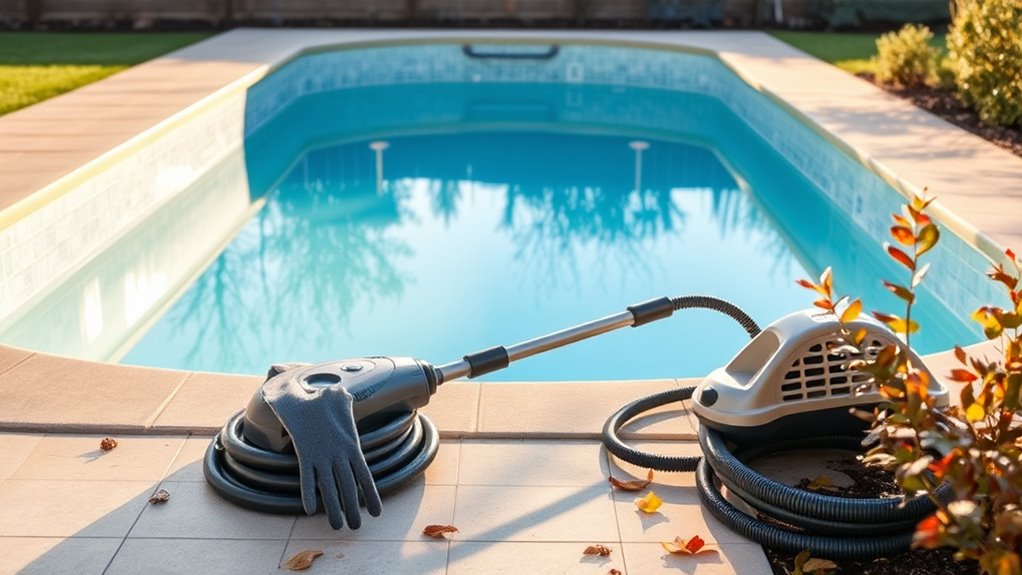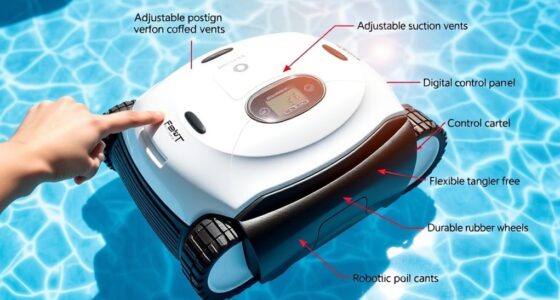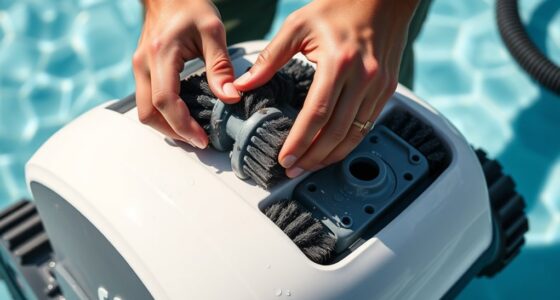To care for your pressure pool cleaner off-season, start by emptying and cleaning the filter and pump basket, then rinse and inspect hoses and cables for damage. Store the device in a dry, elevated area, protecting it from freezing temperatures by draining water and using insulation if needed. Remove nozzles and attachments, and conduct a functional test before storage. Proper maintenance now helps keep your cleaner in top shape for next season—learn more to guarantee it lasts.
Key Takeaways
- Drain all water from hoses, nozzles, and internal components to prevent freezing damage during winter.
- Store the cleaner in a dry, elevated, and well-ventilated area away from extreme temperatures.
- Clean and dry all parts thoroughly before storing to prevent rust and mold formation.
- Cover or insulate the device to protect from moisture, cold, and environmental elements.
- Perform a functional test before reusing in the season to ensure proper operation and identify potential issues.
Empty and Clean the Filter and Pump Basket
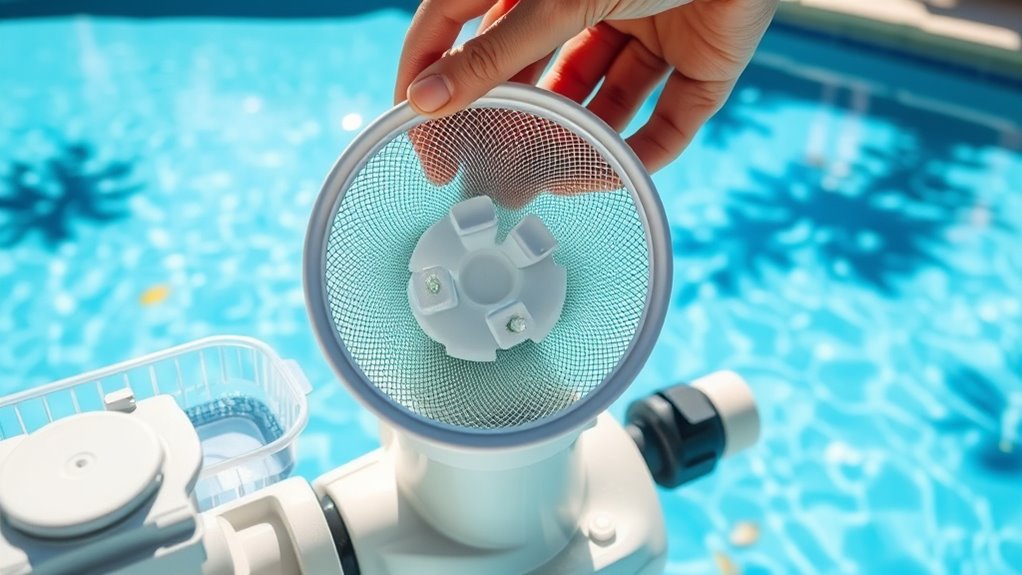
Before storing your pressure pool cleaner for the off-season, you should start by emptying and cleaning the filter and pump basket. Proper filter maintenance guarantees debris doesn’t cause problems later, so remove the baskets and clear out any dirt, leaves, or debris. Rinse them thoroughly with water to prevent buildup. While you’re at it, perform a pump inspection—check for clogs, leaks, or damage, and ensure the impeller moves freely. Clean any debris from the pump’s interior if needed. Taking these steps helps keep your equipment in good shape, prevents mold, and makes reassembling easier when you’re ready to reopen your pool. Regular maintenance now will save you time and hassle in the future. Additionally, considering automation in business can streamline your pool care routines and reduce manual efforts during maintenance. Incorporating proper filtration systems can also enhance overall efficiency and longevity of your pool cleaning equipment. Regularly inspecting your equipment ensures that debris buildup is minimized and your pool stays cleaner during the off-season.
Rinse and Inspect the Hoses and Cables
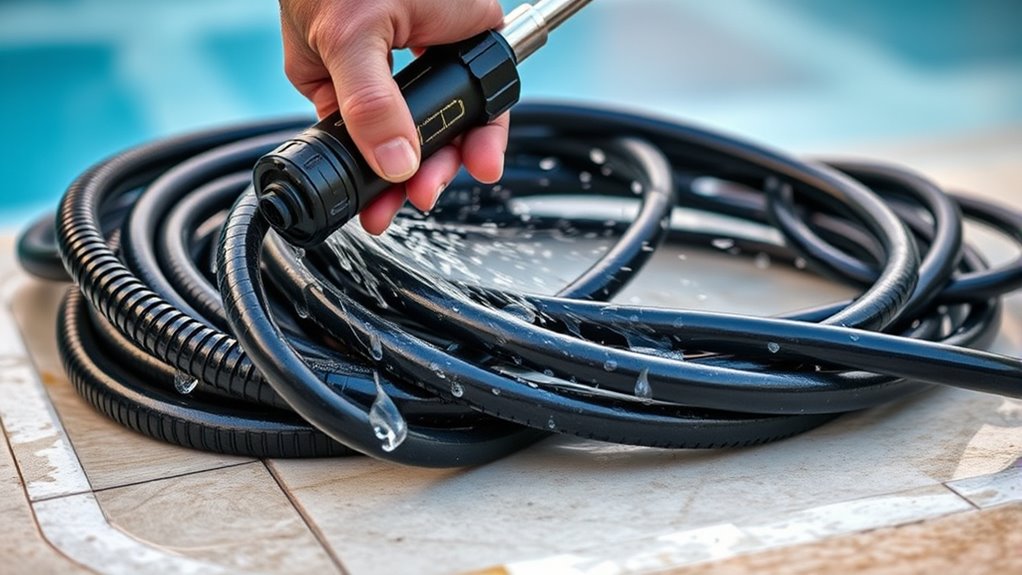
Start by checking your hoses and cables for any signs of damage or wear. Rinse them thoroughly to remove dirt and debris, then dry them completely to prevent mold. Store everything indoors in a dry, protected area to keep your equipment in top condition for next season. Regular inspection of performance upgrades can help ensure your pressure pool cleaner operates efficiently when you need it. Additionally, inspecting the contrast ratio of your equipment can help maintain optimal image quality during operation. Staying informed about industry trends can also assist in choosing the right accessories and parts for maintenance. Remember that examining the material quality of your accessories can further extend their lifespan and performance. Monitoring risk management strategies can help you prepare for any equipment issues that may arise during the off-season.
Check for Damage
Inspecting your pressure pool cleaner’s hoses and cables is essential to guarantee they’re in good shape for the next season. Use an inspection checklist to identify any signs of damage, such as cracks, leaks, or frayed wiring. Damage prevention starts with thorough visual checks to ensure all components are intact. Look for:
- Cuts, tears, or abrasions on hoses and cables
- Loose or missing clamps and connectors
- Signs of mold, mineral buildup, or corrosion
Address any issues immediately to avoid further damage during operation. Regular inspections help prolong your cleaner’s lifespan and ensure maximum performance. Incorporating preventive maintenance techniques into your inspection routine can help you identify potential issues more effectively. Additionally, staying informed about AI safety measures can improve your troubleshooting approach. Being aware of common damage signs can also assist you in diagnosing issues quickly. Recognizing wear and tear patterns early can help prevent unexpected breakdowns. Proper damage detection now sets the stage for a trouble-free pool season ahead.
Clean and Dry Thoroughly
To guarantee your pressure pool cleaner is ready for the next season, it’s essential to thoroughly rinse and dry the hoses and cables. Use a gentle stream of water to remove dirt, debris, and any lingering pool chemicals. Carefully inspect for cracks or wear, ensuring everything is in good condition. For drying, employ proper drying techniques such as hanging hoses in a well-ventilated area or wiping cables with a clean, dry cloth. Avoid leaving moisture on the equipment, as it can cause mold or deterioration. Proper drying and storage help extend the lifespan of your pressure pool cleaner components. Additionally, checking the best laundry detergents can help keep your cleaning tools in top condition. Cultivating a bias to action when maintaining equipment can prevent small issues from becoming larger, costly problems. Implementing sound maintenance practices can further ensure your equipment remains in optimal working order, much like engine tuning enhances vehicle performance for better longevity. Regularly inspecting and maintaining your equipment aligns with preventive maintenance strategies, contributing to its durability and efficiency.
Store Properly Indoors
Once you’ve rinsed and inspected the hoses and cables, storing them indoors guarantees they stay in good condition. Proper indoor storage prevents damage from weather and UV exposure, extending their lifespan. Ensure the space offers temperature control, avoiding extreme heat or cold that could harm the equipment. When storing, coil hoses neatly to prevent kinks or cracks, and wind cables carefully to avoid stress points. Consider these key points:
- Keep hoses and cables in a dry, climate-controlled area
- Avoid direct sunlight and moisture exposure
- Use hooks or shelves for organized storage
- Incorporate appropriate storage solutions to maintain accessibility and protect the equipment from environmental damage
- Additionally, storing in a way that minimizes exposure to UV radiation helps prevent material degradation over time.
- Using proper storage techniques can further prevent unnecessary wear and tear during the off-season.
- For optimal protection, consider wrapping hoses and cables in protective coverings or sleeves to shield them from dust and potential abrasions.
Check for Signs of Wear or Damage
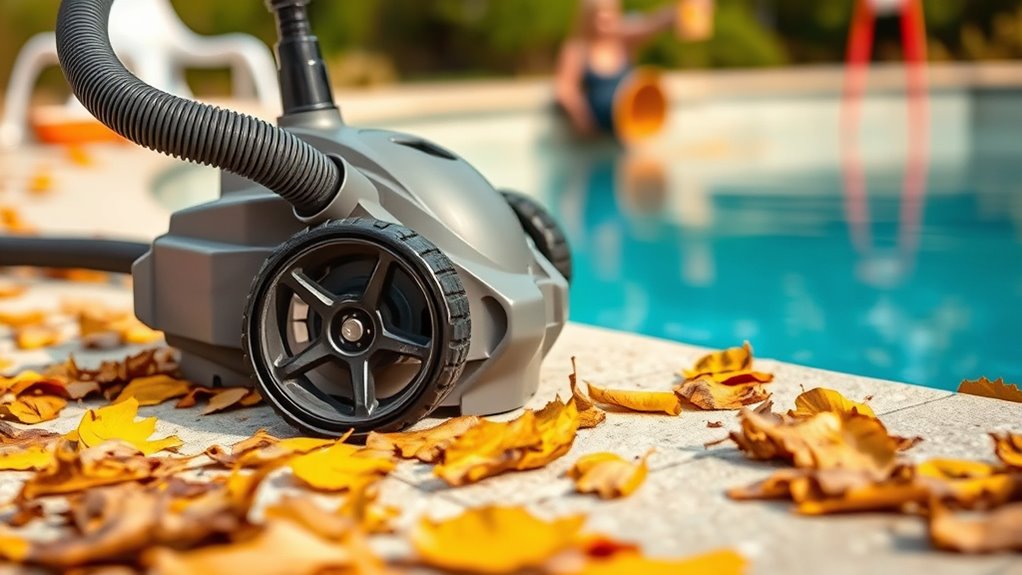
Since pressure pool cleaners are exposed to harsh chemicals and constant water flow, maintaining regular inspections for signs of wear or damage is vital. Check hoses, fittings, and seals for cracks, leaks, or signs of deterioration that could compromise performance. Look closely at the brushes and jets for any wear and tear that might reduce cleaning efficiency. Inspect the structural integrity of the main body for cracks or warping. Damaged or worn parts can lead to leaks or breakdowns, so replace them promptly. Maintaining these checks ensures your cleaner functions properly when next in use and prevents costly repairs. Regular inspection is a simple step that keeps your pressure pool cleaner operating smoothly during the off-season and beyond. Incorporating AI-powered diagnostics can help identify potential issues early, further safeguarding your equipment’s performance. Additionally, staying informed about celebrity lifestyle insights can offer inspiring ideas for creating a relaxing retreat around your pool area. Paying attention to tuning principles such as routine checks and upgrades can extend the lifespan of your equipment and optimize its efficiency. Remember, preventive maintenance is key to avoiding unexpected failures and ensuring longevity of your pressure pool cleaner.
Store the Cleaner in a Dry, Elevated Area
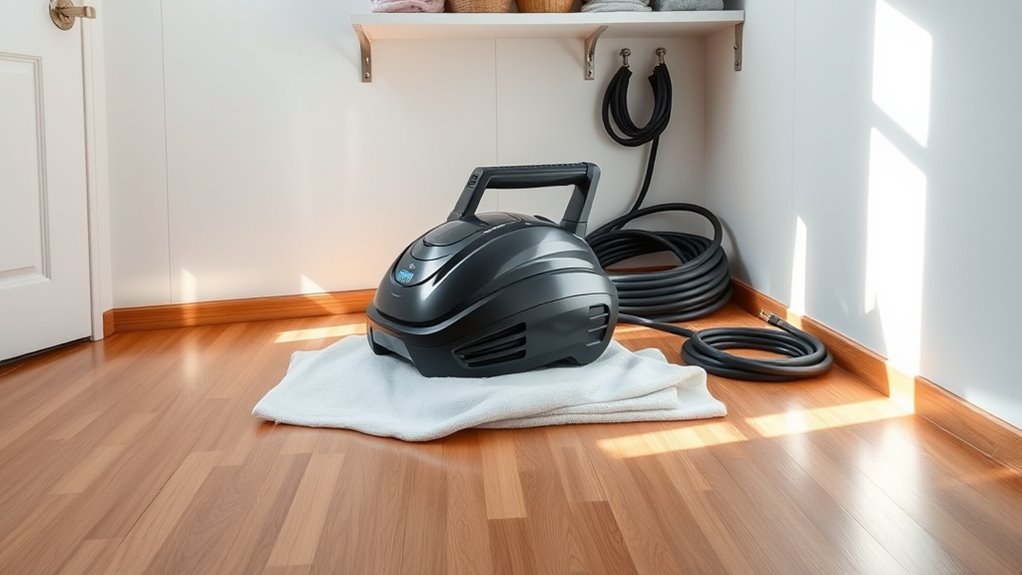
You should store your pressure pool cleaner in a dry, protected spot to guarantee rust and damage. Elevate it off the ground to avoid contact with moisture and potential pests. Keep it away from humid environments to ensure it stays in good condition over the off-season.
Keep Dry Storage
To prevent damage during the off-season, it’s essential to store your pressure pool cleaner in a dry, elevated area. This helps guarantee electrical safety and moisture prevention, reducing the risk of corrosion or electrical issues. Keep the cleaner off the ground to avoid exposure to humidity and water. Consider the following for ideal storage:
- Use a ventilated, dry space to prevent mold and rust
- Ensure the area remains free of moisture and condensation
- Store in a clean, protected spot away from extreme temperatures
Elevate to Prevent Damage
Elevating your pressure pool cleaner off the ground is one of the best ways to protect it during the off-season. Use an elevate platform or a sturdy shelf to keep it raised, preventing direct contact with damp surfaces. This position helps guarantee the cleaner stays dry and reduces the risk of corrosion caused by moisture buildup. By keeping it elevated, you also prevent accidental damage from foot traffic or heavy objects. Make sure the platform is stable and level to avoid tipping or stress on hoses and components. Proper elevation allows air circulation around the unit, further guarding against moisture retention. Investing in a good elevate platform now can extend the life of your pressure pool cleaner and keep it in optimal condition for use when the season begins again.
Avoid Humid Environments
Storing your pressure pool cleaner in a dry, elevated area is crucial for preventing moisture buildup and corrosion. In humid climates, excess moisture can accelerate rust and damage essential components. To avoid this, choose a storage spot that’s well-ventilated and away from damp walls or floors. Consider these tips:
- Keep the cleaner off the ground on a shelf or rack
- Use a dehumidifier or silica gel packs to control humidity
- Make certain the storage area is clean and free from standing water
Protect the Device From Freezing Temperatures

Freezing temperatures can severely damage your pressure pool cleaner if left unprotected during the off-season. To prevent this, follow winterization tips that focus on freezing prevention. Start by draining all water from the device, paying close attention to hoses, nozzles, and internal components. Store the cleaner in a dry, insulated area to avoid exposure to cold drafts. Consider using a pool cover that helps maintain a consistent temperature and prevents ice formation. If your climate experiences extreme cold, use a non-toxic antifreeze designed for pool equipment, but only if recommended by the manufacturer. Proper winterization ensures that your pressure pool cleaner stays in good condition and is ready for use when the season begins again.
Lubricate Moving Parts if Recommended

Check your manufacturer’s instructions to see if lubrication is advised for your pressure pool cleaner’s parts. Use only the appropriate lubricant suggested in the guide to avoid damage. Following these guidelines ensures your cleaner stays in good shape for next season.
Use Appropriate Lubricant
If your pressure pool cleaner has moving parts that require lubrication, applying the correct lubricant can help guarantee smooth operation during the off-season. Using an appropriate lubricant tailored for your pressure cleaner prevents rust, reduces wear, and ensures longevity. Be sure to:
- Choose a lubricant compatible with plastic and rubber components
- Apply sparingly to avoid excess buildup
- Focus on joints, gears, and any pivot points
Using the right lubricant not only protects your pressure cleaner but also maintains ideal performance when you resume cleaning. Always verify that the lubricant is suitable for pool equipment, as improper products can cause damage or reduce efficiency. Taking these steps ensures your pressure cleaner stays in top shape during the off-season and is ready for action when needed.
Follow Manufacturer Guidelines
Following the manufacturer’s guidelines guarantees you use the correct lubrication practices for your pressure pool cleaner. Always consult the user manual before applying any lubricant, as manufacturer instructions specify whether lubrication is necessary and which products to use. Using the wrong type or amount of lubricant can damage components or reduce efficiency. Adhering to these guidelines ensures you protect moving parts while avoiding voiding warranties. If the manual recommends lubrication, follow the specified intervals and procedures carefully. This proactive step helps prevent corrosion, reduces wear, and extends your cleaner’s lifespan. By respecting manufacturer instructions, you ensure your pressure pool cleaner operates smoothly during the off-season and beyond.
Remove and Store the Pressure Nozzle and Attachments
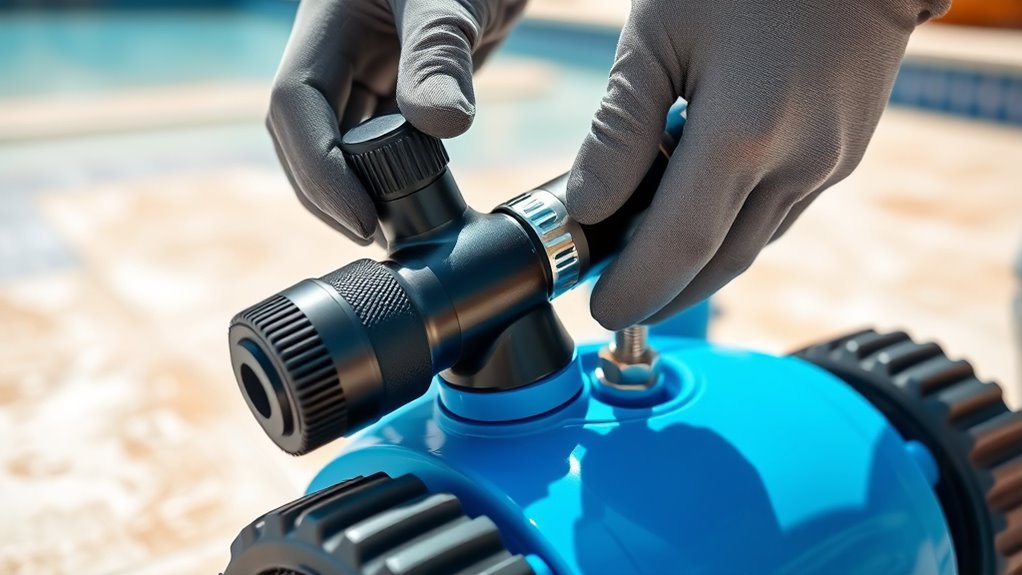
Before storing your pressure pool cleaner for the off-season, it’s important to remove the pressure nozzle and attachments. Removing these parts prevents damage and guarantees proper attachment storage. Carefully detach the pressure nozzle and any other accessories, inspecting them for debris or wear. Proper attachment storage keeps your equipment organized and ready for use next season. When storing, consider these tips:
Remove and inspect pressure nozzles and attachments before storing to prevent damage and keep equipment organized.
- Clean the pressure nozzle and attachments thoroughly before storage
- Dry all parts completely to prevent mold and corrosion
- Store attachments in a dedicated container or compartment
This approach prolongs the lifespan of your pressure nozzle and ensures all components remain in good condition, ready for the next swimming season. Proper removal and attachment storage are essential steps in off-season pool equipment care.
Conduct a Functional Test Before Storage

Conducting a functional test of your pressure pool cleaner guarantees it’s in proper working order before storage. Start by powering it on and observing its operation, ensuring all parts move smoothly. Check the brushes and wheels for proper rotation, and listen for unusual noises. During functional testing, verify that the water flow is consistent and that the cleaner’s sensors respond correctly. Also, perform a battery calibration if applicable, to guarantee the battery’s accuracy and longevity. Use this simple checklist to confirm readiness:
| Step | Action |
|---|---|
| 1 | Power on and observe operation |
| 2 | Check water flow and sensors |
| 3 | Perform battery calibration |
A thorough test prevents surprises when you restart it next season.
Keep the Power Cord and Connectors Tainted From Debris
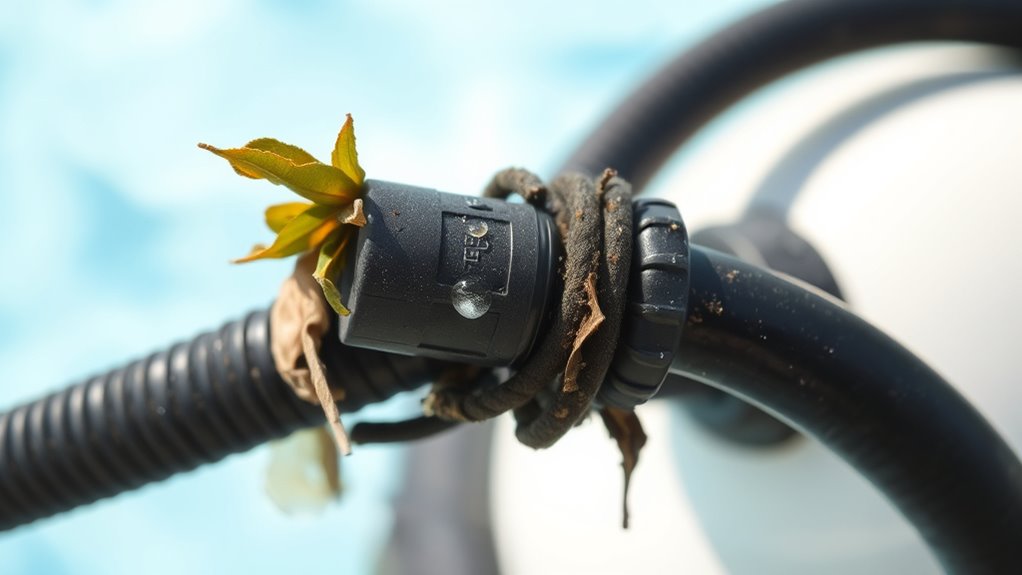
After testing your pressure pool cleaner, it’s important to make certain the power cord and connectors stay free of debris. Proper power cord maintenance ensures peak performance and extends the lifespan of your equipment. Regularly inspect the cord for any signs of wear or damage, and clean connectors to prevent corrosion.
To maintain the connectors and cord effectively, consider these steps:
- Gently wipe connectors with a damp cloth to remove dirt and algae.
- Use a soft brush to clean the connectors if debris is stubborn.
- Ensure connectors are completely dry before storage to prevent rust and electrical issues.
Maintain Documentation and Schedule Routine Checks
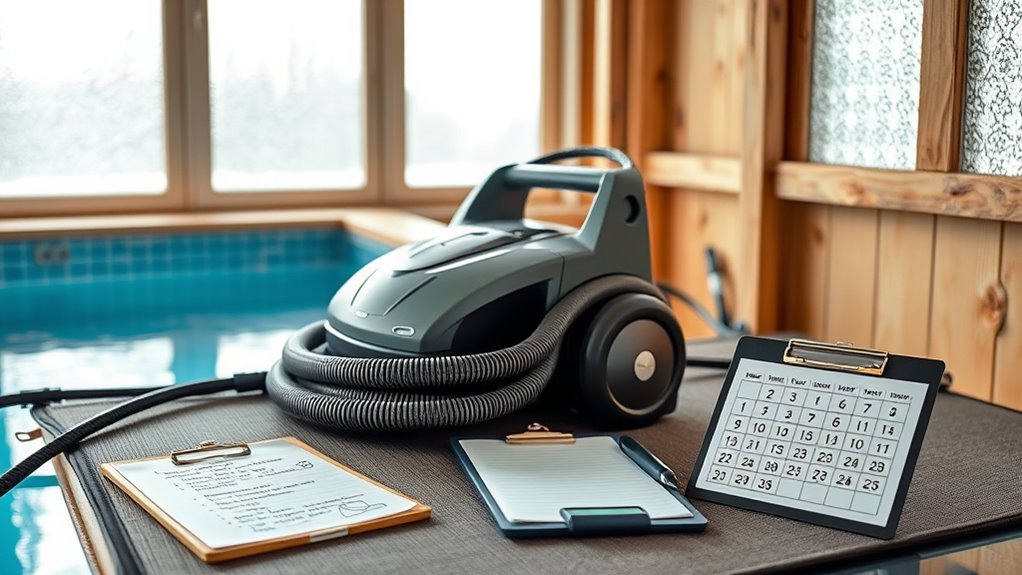
Keeping detailed records of your pressure pool cleaner’s maintenance and usage helps you track its performance and identify potential issues early. Maintain thorough maintenance records, noting when you clean filters, replace parts, or perform repairs. This documentation makes it easier to spot patterns that could indicate problems before they worsen. Additionally, scheduling inspections at regular intervals ensures your cleaner remains in prime condition during the off-season. Use a checklist to track essential checks, such as inspecting hoses, connections, and the motor. Consistently updating these records and sticking to your scheduled inspections prolongs your cleaner’s lifespan and saves you money. By staying organized and proactive, you’ll ensure your pressure pool cleaner is ready to perform when the season starts.
Frequently Asked Questions
How Often Should I Perform Off-Season Maintenance on My Pressure Pool Cleaner?
You should perform off-season maintenance on your pressure pool cleaner at least once a month. Focus on winter preparation by thoroughly cleaning and inspecting the unit. Check and adjust chemical balancing in your pool to prevent algae and corrosion. Store the cleaner properly, making certain all parts are dry and free of debris. Regular maintenance helps extend its lifespan and ensures it’s ready to perform when you reopen your pool in the season.
Can I Leave the Pressure Cleaner in the Pool During Off-Season?
You can leave your pressure pool cleaner in the pool during off-season, but it’s not advisable. Changes in pool chemistry can cause equipment wear and reduce durability over time. To protect your cleaner, it’s best to store it properly, rinse it thoroughly, and keep it in a dry, cool place. This helps maintain the equipment’s longevity and ensures it works efficiently when you need it again.
What Are Common Signs Indicating My Cleaner Needs Repairs Before Storage?
You might think your pressure pool cleaner is fine, but ignoring repair indicators can cause bigger issues later. Before storage preparation, check for signs like strange noises, reduced suction, or leaks. These repair indicators suggest it needs attention now. Addressing these issues guarantees your cleaner works efficiently when you need it again. Don’t skip this step—proper maintenance now saves you time and money during off-season storage.
Is It Necessary to Replace Parts During Off-Season Storage?
You might wonder if replacing parts is necessary during storage. It’s best to do a thorough parts inspection before storing your pressure pool cleaner. If you notice worn or damaged components, substitute them to prevent issues later. Follow proper storage techniques, like cleaning and drying the device, to keep parts in good shape. This ensures your cleaner stays ready for use and prolongs its lifespan when the season resumes.
How Do I Troubleshoot Issues After Removing the Cleaner From Storage?
Think of troubleshooting issues after storage as revealing hidden treasures. First, follow storage tips to guarantee your cleaner’s components are clean and dry. Check for clogged hoses or worn-out parts, and ensure connections are secure. Perform basic troubleshooting steps like testing the motor and inspecting brushes. If problems persist, consider consulting your manual or seeking professional help. Proper storage and regular checks keep your pressure pool cleaner ready for action.
Conclusion
Properly caring for your pressure pool cleaner during off-season guarantees it stays in top shape for next summer. By cleaning, inspecting, and storing it correctly, you prevent damage and extend its lifespan. Are you ready to keep your pool equipment ready for effortless cleaning when the season returns? A little maintenance now saves you time and money later. Take these simple steps, and your pressure cleaner will be waiting, just as ready as you are for the next swim.
